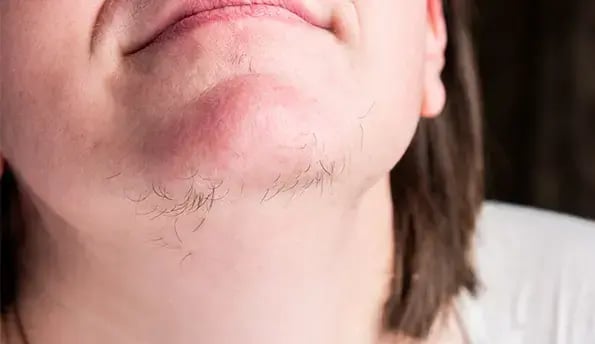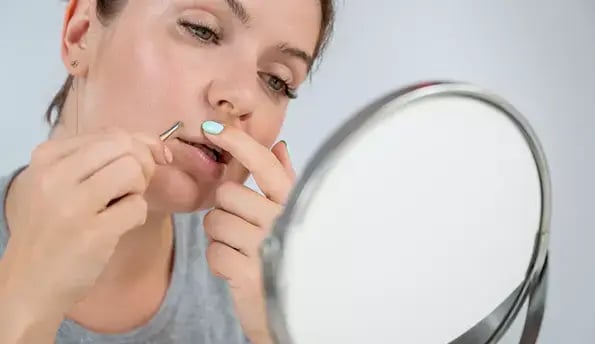What is Hirsutism?
Excessive Female Hair Growth Disorder
Hirsutism is an increase in coarse hair growth in male-specific areas in females. Usually, in areas such as the beard, mustache, chest, back, under the navel, above the navel, and coccyx, male sex-specific hair is physiological (nature specific to the breed). In contrast, women may have fine hair in these areas, but this coarse-thick hair growth is not average. Hair/hair density may differ in women due to genetic factors, which may be a standard variant.

Hirsutism vs. Hypertrichosis
Hirsutism is defined as an “excessive increase in terminal hair in women, which is more specific to men.” Hypertrichosis is “excessive hair growth in non-androgen-dependent areas of the skin.” The causes of hirsutism are numerous, and generalized and localized congenital Hypertrichosis is one of them. Subsequent Hypertrichosis may be associated with the use of certain drugs (including androgens, minoxidil, and cyclosporine, among others) and syndromic hypertrichosis. Hirsutism may be related to familial endocrine syndromes (such as polycystic ovarian disease) or tumors of the gland, pituitary, and ovary or may be associated with the use of certain medications, including androgens.
Whatever the cause, Hirsutism and Hypertrichosis can have severe psychological consequences. There are countless treatments for hypertrichosis and hirsutism, each with a different success rate. Topical drugs, wax, chemical epilation, electrolysis, and laser treatment are the methods used to eliminate excess hair.
Our mission is to create a world where every investment in modern beauty is Worth It.
Let's keep in touch
Get updates of the treatments you are interested
What Causes Hirsutism?
Idiopathic Hirsutism
In some of the patients, there is no specific reason for excessive hair growth. Although androgen levels are within normal limits, this condition is defined as “Idiopathic Hirsutism” in patients with excessive hair growth, no polycystic ovaries in ovarian ultrasonography, and no menstrual irregularity.

Diagnosing Hirsutism
Treating Hirsutism
Treatment of hirsutism depends on whether the disorder has an underlying cause. If a disease is detected at its source, its primary treatment should be treating the underlying condition. Although hirsutism is perceived as a cosmetic problem, it is essential because it can be a sign of severe and hormonal diseases. Hirsutism regresses with the treatment of the underlying condition. Hirsutism can be a result of polycystic ovary syndrome (PCOS). In this case, oral contraceptive (OCS) agents, also used in treating POCOS, cause regression in hair growth.
The effects of oral contraceptives on the hair begin in the 4th month, and the net result is seen in the 6th month. Its effectiveness continues as long as it is used. Antiandrogen therapies are other medical treatments used in eligible patients. If the patient has a simultaneous pregnancy plan, hormonal therapy is unsuitable. Sometimes no underlying disease can be found. In this case, called idiopathic hirsutism, mechanical methods (hair removal with razor, wax, laser/needle epilation) can be applied.
Our mission is to create a world where every investment in modern beauty is Worth It.
Let's keep in touch
Get updates of the treatments you are interested
Longer-lasting Hair Removal
An endocrinology specialist must be on the team, not only for long-term hair removal but also for providing long-term hairlessness to these patients. These patients may have endocrine abnormalities such as insulin resistance or obesity. In addition, a dermatologist, an obstetrician dealing with reproductive endocrinology, and a radiologist should be part of the team. For treating patients with obesity problems, it is helpful to have a dietitian and, if possible, a therapist experienced in behavioral therapy. All this creates a multidisciplinary team. For patients, the focus is primarily on finding the underlying cause of the excessive hair growth problem as a team.
Drug treatment is used in polycystic ovarian syndrome and hirsutism of unknown cause, primarily seen in people who apply with excessive hair growth. In addition to regular drug use for at least six months, cosmetic treatment can be applied if necessary. It should be remembered that treating excessive hair growth is not permanent; chronic treatment may be required, and drugs can only take effect within months. It is essential to continue regular medical check-ups during this period.
Living with Hirsutism?
Excessive Female Hair Growth Disorder
Hirsutism is an increase in coarse hair growth in male-specific areas in females. Usually, in areas such as the beard, mustache, chest, back, under the navel, above the navel, and coccyx, male sex-specific hair is physiological (nature specific to the breed). In contrast, women may have fine hair in these areas, but this coarse-thick hair growth is not average. Hair/hair density may differ in women due to genetic factors, which may be a standard variant.

Hirsutism vs. Hypertrichosis
Hirsutism is defined as an “excessive increase in terminal hair in women, which is more specific to men.” Hypertrichosis is “excessive hair growth in non-androgen-dependent areas of the skin.” The causes of hirsutism are numerous, and generalized and localized congenital Hypertrichosis is one of them. Subsequent Hypertrichosis may be associated with the use of certain drugs (including androgens, minoxidil, and cyclosporine, among others) and syndromic hypertrichosis. Hirsutism may be related to familial endocrine syndromes (such as polycystic ovarian disease) or tumors of the gland, pituitary, and ovary or may be associated with the use of certain medications, including androgens.
Whatever the cause, Hirsutism and Hypertrichosis can have severe psychological consequences. There are countless treatments for hypertrichosis and hirsutism, each with a different success rate. Topical drugs, wax, chemical epilation, electrolysis, and laser treatment are the methods used to eliminate excess hair.
Our mission is to create a world where every investment in modern beauty is Worth It.
Let's keep in touch
Get updates of the treatments you are interested
What Causes Hirsutism?
Idiopathic Hirsutism
In some of the patients, there is no specific reason for excessive hair growth. Although androgen levels are within normal limits, this condition is defined as “Idiopathic Hirsutism” in patients with excessive hair growth, no polycystic ovaries in ovarian ultrasonography, and no menstrual irregularity.

Diagnosing Hirsutism
Treating Hirsutism
Treatment of hirsutism depends on whether the disorder has an underlying cause. If a disease is detected at its source, its primary treatment should be treating the underlying condition. Although hirsutism is perceived as a cosmetic problem, it is essential because it can be a sign of severe and hormonal diseases. Hirsutism regresses with the treatment of the underlying condition. Hirsutism can be a result of polycystic ovary syndrome (PCOS). In this case, oral contraceptive (OCS) agents, also used in treating POCOS, cause regression in hair growth.
The effects of oral contraceptives on the hair begin in the 4th month, and the net result is seen in the 6th month. Its effectiveness continues as long as it is used. Antiandrogen therapies are other medical treatments used in eligible patients. If the patient has a simultaneous pregnancy plan, hormonal therapy is unsuitable. Sometimes no underlying disease can be found. In this case, called idiopathic hirsutism, mechanical methods (hair removal with razor, wax, laser/needle epilation) can be applied.
Our mission is to create a world where every investment in modern beauty is Worth It.
Let's keep in touch
Get updates of the treatments you are interested
Longer-lasting Hair Removal
An endocrinology specialist must be on the team, not only for long-term hair removal but also for providing long-term hairlessness to these patients. These patients may have endocrine abnormalities such as insulin resistance or obesity. In addition, a dermatologist, an obstetrician dealing with reproductive endocrinology, and a radiologist should be part of the team. For treating patients with obesity problems, it is helpful to have a dietitian and, if possible, a therapist experienced in behavioral therapy. All this creates a multidisciplinary team. For patients, the focus is primarily on finding the underlying cause of the excessive hair growth problem as a team.
Drug treatment is used in polycystic ovarian syndrome and hirsutism of unknown cause, primarily seen in people who apply with excessive hair growth. In addition to regular drug use for at least six months, cosmetic treatment can be applied if necessary. It should be remembered that treating excessive hair growth is not permanent; chronic treatment may be required, and drugs can only take effect within months. It is essential to continue regular medical check-ups during this period.






